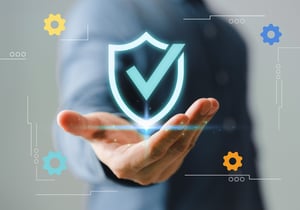As the cybersecurity landscape continues to evolve, organizations must continuously adapt their defenses to counter emerging threats effectively. Businesses must implement robust frameworks that safeguard their digital assets and sensitive information. The National Institute of Standards and Technology (NIST) has been at the forefront of meeting these needs by providing valuable guidance to bolster cybersecurity practices by creating a Cybersecurity Framework (CSF).
NIST initially released the CSF in 2014 to address ever-changing cybersecurity threats and to help organizations manage cybersecurity risks more effectively. The CSF was intended to be a living document that would be refined and improved, such as the update to CSF 1.1 in April 2018. CSF 2.0 was published on February 26, 2024, and introduced several key changes to the framework. One of the most significant changes is the addition of the sixth function: Govern. This new function emphasizes the importance of effective governance, risk management, and compliance.
With CSF 2.0, NIST has significantly broadened the framework’s scope to include emerging technologies like cloud computing, Zero Trust architectures, Internet of Things (IoT, and mobile devices. Additionally, a new category for Cybersecurity Supply Chain Risk Management and Platform Security has been added to address contemporary challenges. CSF 2.0 also introduces new Quick Start Guides for creating profiles tailored to an organization's unique risk posture, as well as Implementation Tiers, making it much more aligned with current regulatory guidance.
NIST CSF 1.0 vs 2.0 Scope and Approach Comparison
NIST CSF 1.0 laid the groundwork for organizations to manage and improve their cybersecurity risk management practices. The framework consists of five core functions: identify, protect, detect, respond, and recover. While widely adopted and beneficial, the approach was generalized, lacking the specificity found in its successor.
NIST CSF 2.0 is a comprehensive set of guidelines, standards, and best practices to help organizations manage and improve their cybersecurity posture. CSF 2.0 builds upon the foundation set by its predecessor and introduces more detailed and refined guidelines, aligning with the evolving nature of cybersecurity threats. The latest version addresses advanced persistent threats, incorporates emerging technologies, and emphasizes continuous monitoring and improvement. CSF 2.0 provides organizations with a more comprehensive framework to tackle modern cybersecurity challenges effectively.
Core Functions
Let us explore how the advancement in the latest version enhances cybersecurity measures for businesses.
Five of the core functions of CSF 1.0 and 2.0 are the same, yet 1.0’s guidance was notably more general compared to the depth and granularity provided in CSF 2.0.
Identify
- CSF 1.0 offered general guidelines for risk assessment without detailed methodologies.
- CSF 2.0 introduces in-depth risk assessment methodologies with a specific focus on supply chain risks and third-party dependencies. Organizations must understand their assets and the risks they face and clearly understand their cybersecurity requirements. This includes conducting regular risk assessments and asset inventories and understanding the potential impact of cyber threats on their operations.
Protect
- CSF 1.0 provided broad recommendations for safeguarding assets without specific guidance for Internet of Things (IoT) devices and encryption techniques.
- CSF 2.0 delivers specific guidance for IoT devices, advanced encryption, and secure communication protocols. The protection function focuses on implementing safeguards to ensure the security and integrity of critical assets. This involves deploying access controls, encryption, multi-factor authentication, and establishing secure configurations for systems and applications.
Detect
- CSF 1.0 acknowledged real-time threat intelligence without delving into artificial intelligence and machine learning integration.
- CSF 2.0 emphasizes the use of real-time threat intelligence, sharing among organizations, and leveraging AI and machine learning for threat detection. Detection is crucial for promptly identifying potential cybersecurity incidents. Organizations must deploy monitoring and alerting mechanisms to detect real-time anomalies, intrusions, or unauthorized access attempts, enabling swift responses to mitigate potential threats.
Respond
- CSF 1.0 focused on coordination during incident response but without an emphasis on proactive strategies.
- CSF 2.0 expands on communication, coordination, threat hunting, and proactive incident response. An effective response plan is essential to contain and mitigate the impact of cybersecurity incidents. Organizations should establish incident response protocols, including communication channels, coordination with stakeholders, and a step-by-step guide for managing incidents efficiently.
Recover
- CSF 1.0 mentioned incident recovery plans without extensive guidance for continuous improvement.
- CSF 2.0 provides detailed guidance on developing and testing incident recovery plans, along with learning from past incidents for continuous improvement. The recovery function focuses on restoring systems and operations to normalcy after a cybersecurity incident. This involves performing data backups, having contingency plans, and conducting post-incident analyses to prevent similar occurrences in the future.
Introduction of the Govern Function
The Govern function is at the center of NIST CSF 2.0 as it sets the foundation and informs how an organization will implement the other five functions. The Govern function of 2.0 ensures that cybersecurity is incorporated into an organization's broader enterprise risk management strategy. It provides outcomes to prioritize other functions in the context of organizational mission and stakeholder expectations. The Govern function addresses the understanding of organizational context, cybersecurity strategy and supply chain risk management, roles, responsibilities, authorities, policy, and oversight of cybersecurity strategy. The activities of the Govern function are critical for the success of the 2.0 implementation.

Additionally, the Govern function supports organizational risk communication with executives. Executives’ discussions involve strategy, particularly how cybersecurity-related uncertainties might affect the achievement of organizational objectives. These governance discussions support dialogue and agreement about risk management strategies (including cybersecurity supply chain risk); roles, responsibilities, and authorities; policies; and oversight. As executives establish cybersecurity priorities and objectives based on those needs, they communicate expectations about risk appetite, accountability, and resources. Executives are also responsible for integrating cybersecurity risk management with ERM programs and lower-level risk management programs. The communications reflected in the top half of the image below can include considerations for ERM and the lower-level programs and, thus, inform managers and practitioners.

New Subcategories
NIST CSF 2.0 introduces several new subcategories to enhance the framework’s comprehensiveness and applicability in today’s cybersecurity environment.
-
The Identify function has a new subcategory for Asset Management (ID.AM-07) which states that inventories of data and corresponding metadata for designated data types are maintained. Another new subcategory is Improvement (ID.IM-01) which states that improvements are identified from evaluations.
-
In the Protect function, there are new subcategories for Identity Management, Authentication, and Access Control (PR.AA-04) which states that identity assertions are protected, conveyed, and verified. Additionally, there is a new category for Platform Security (PR.PS) which states that the hardware, software, and services of physical and virtual platforms are managed consistent with the organization's risk strategy to protect their confidentiality, integrity, and availability.
These updates provide a more detailed and structured approach to managing cybersecurity risks across various organizational functions.
Benefits of Implementing NIST CSF 2.0
Adopting NIST CSF 2.0 offers numerous advantages:
- Enhanced cybersecurity posture through more precise and actionable guidelines.
- Alignment with industry standards helps maintain compliance and best practices.
- Risk reduction by addressing both current and emerging cybersecurity threats.
- Improved incident response capabilities enable quicker and more effective reactions to security breaches.
- Increased customer trust as a result of demonstrating a commitment to robust cybersecurity measures.
Quick Start Guides for CSF 2.0
The Quick Start Guides are designed to assist organizations in effectively understanding and implementing the CSF 2.0 framework:
- Resource and Overview Guide: This guide provides the basics of CSF 2.0 and outlines the resources available to help the organization implement the framework.
- Organizational Profiles Guidance: This guidance assists organizations in creating and using profiles, which are spreadsheets that describe an organization’s current and/or target cybersecurity posture based on CSF 2.0 outcomes.
- Community Profiles: This guide offers considerations for creating Community Profiles, which support an organization's needs in communities with common cybersecurity priorities.
- Small Business Resources: This guide, tailored to small businesses, provides considerations for kick-starting their cybersecurity risk management strategy using CSF 2.0.
- Cybersecurity Supply Chain Risk Management (C-SCRM): This helps organizations become smarter acquirers and suppliers of technology products and services.
- Tiers: Organizations can use this guide to apply the CSF 2.0 Tiers to Profiles characterizing the rigor of their cybersecurity risk governance and management outcomes.
- Enterprise Risk Management (ERM): This guide shows how ERM practitioners can utilize the outcomes provided in CSF 2.0 to improve organizational cybersecurity risk management.
These guides were created to help organizations of all sizes and types navigate CSF 2.0 and enhance their cybersecurity measures. They provide a structured approach to assessing and improving cybersecurity practices, tailored to the specific needs and profiles of each organization.
Implementing NIST 2.0
To successfully roll out CSF 2.0, organizations should consider the following structured approach:
-
Management Support: Leadership buy-in is crucial as it ensures the allocation of adequate resources and demonstrates a commitment to the cybersecurity framework's implementation.
-
Current Cybersecurity Assessment: Ensure your current assessment has been conducted in-depth identifying the organization’s strengths and weaknesses.
-
Gap Analysis: Compare current cybersecurity measures against the CSF 2.0 guidelines to pinpoint gaps and areas needing enhancement.
-
Develop and Implement a Plan: Craft a detailed action plan that aligns with CSF 2.0 standards and prioritize initiatives based on associated risk levels.
-
Training and Awareness: Continue to educate employees on the importance of cybersecurity and their roles in maintaining a secure environment.
-
Continuing Monitoring and Improvement: Craft a detailed action plan that aligns with CSF 2.0 standards and prioritize initiatives based on associated risk levels.
To ensure an understanding of how to implement CSF 2.0, NIST has provided Informative References, which include implementation examples. For every function, category, and sub-category, an implementation example is provided to assist in achieving the desired outcome.
NIST CSF 2.0 Implementation Examples
| Category | Subcategory | Implementation Examples |
| Organizational Context (GV.OC): The circumstances - mission, stakeholder expectations, dependencies, and legal, regulatory, and contractual requirements - surrounding the organization's cybersecurity risk management decisions are understood | ||
| GV.OC-01: The organizational mission is understood and informs cybersecurity risk management | Ex1: Share the organization's mission (e.g., through vision and mission statements, marketing, and service strategies) to provide a basis for identifying risks that may impede that mission | |
| GV.OC-02: Internal and external stakeholders are understood, and their needs and expectations regarding cybersecurity risk management are understood and considered | Ex1: Identify relevant internal stakeholders and their cybersecurity-related expectations (e.g., performance and risk expectations of officers, directors, and advisors; cultural expectations of employees) Ex2: Identify relevant external stakeholders and their cybersecurity-related expectations (e.g., privacy expectations of customers, business expectations of partnerships, compliance expectations of regulators, ethics expectations of society) |
|
| GV.OC-03: Legal, regulatory, and contractual requirements regarding cybersecurity - including privacy and civil liberties obligations - are understood and managed | Ex1: Determine a process to track and manage legal and regulatory requirements regarding protection of individuals' information (e.g., Health Insurance Portability and Accountability Act, California Consumer Privacy Act, General Data Protection Regulation) Ex2: Determine a process to track and manage contractual requirements for cybersecurity management of supplier, customer, and partner information Ex3: Align the organization's cybersecurity strategy with legal, regulatory, and contractual requirements |
|
| GV.OC-04: Critical objectives, capabilities, and services that external stakeholders depend on or expect from the organization are understood and communicated | Ex1: Establish criteria for determining the criticality of capabilities and services as viewed by internal and external stakeholders Ex2: Determine (e.g., from a business impact analysis) assets and business operations that are vital to achieving mission objectives and the potential impact of a loss (or partial loss) of such operations Ex3: Establish and communicate resilience objectives (e.g., recovery time objectives) for delivering critical capabilities and services in various operating states (e.g., under attack, during recovery, normal operation) |
February 26, 2024
While NIST CSF 1.0 laid foundational cybersecurity guidelines, CSF 2.0 is set to elevate organizational cybersecurity strategies significantly. It offers detailed guidance, addresses emerging threats, and harmonizes with industry standards, providing organizations with a comprehensive approach to enhance their cybersecurity resilience. By adopting CSF 2.0, organizations not only fortify their defenses but also boost trust among customers and stakeholders.
![]()
Get Your Board Cyber-Ready

NIST CSF is a vital set of guidelines, best practices, and standards relating to information and cybersecurity. Does your organization meet the framework guidelines? Find out with our NIST CSF Assessment.
Identify and Bridge ISP Gaps
This webinar is for you if you use NIST CSF or are looking at adopting this framework. Learn how to leverage the CSF 2.0 to enhance your cybersecurity posture and resilience.


.png?width=400&name=SBSIWebinarsBundles_WebMenu%20(1).png)
